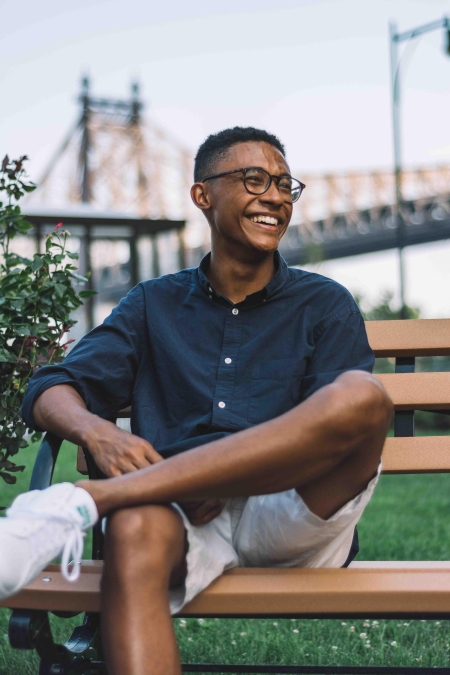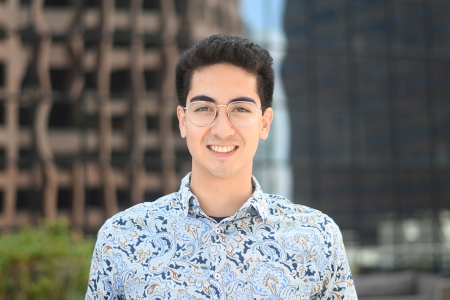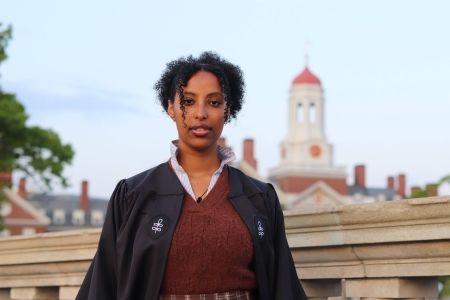On May 10, 2023, four students were named winners of the Visiting Committee Prize for Undergraduate Book Collecting. Ishaan Prasad ’23 was awarded first prize of $3,000 for his entry “Confessions of a Former Sheep Thief: Ten Years of Exploration in Typography.” William Lohier ’23 was awarded second prize of $1,500 for his entry “Words of Safety, Worlds of Survival: Literary Future Histories and Black Speculative Worldbuilding.” Simon Levien ’24 and Birukti Tsige ’23 were co-awarded third prizes of $750 each for their entries “The Imagined Landscape: Collecting the Distortions of People and Place” and “Black Magic: Magic in Young Adult African and African American Fiction,” respectively.
Established in 1977, the Visiting Committee Prize for Undergraduate Book Collecting is awarded annually to recognize and encourage book collecting by undergraduates at Harvard. It is sponsored by the Members of the Board of Overseers’ Committee to Visit the Harvard Library. Students competing for the book-collecting prize submit an annotated bibliography and an essay on their collecting efforts; the influence of mentors; the experience of searching for, organizing and caring for items; and the future direction of the collection. Entries are judged on the purpose, consistency, and quality of the collection and the presentation of the essay and bibliography, not the collection’s size, cost or rarity.
The judges this year were:
- Yoohna Hwang, librarian for undergraduate support, Services for Academic Programs
- Honor Moody, metadata creation manager, Harvard Library
- Matthew Noe, lead collection and knowledge management librarian, Countway Library
- Lynn Sayers, administration and events coordinator, Maps and Media Services
- Carol Tierney, collection development assistant

“Confessions of a Former Sheep Thief: Ten Years of Exploration in Typography”
Ishaan Prasad ’23
“For the past decade, I have been captivated by typography — the art of designing and arranging the visual elements of language. My fascination with typography began in digital media, where I was first introduced to fonts, typefaces, and the importance of visual hierarchy while designing for iOS and the Web. As my interest in typography grew, I began to explore the world of physical and print media and soon discovered the vast range of creative possibilities in this area. I was captivated by the intricate details and subtleties of different typefaces and how they could transform a simple text block into a visually stunning work of art. I began collecting books and ephemera that featured interesting typography and soon found myself lost in the world of graphic design. From vintage typewriters to modern-day printing presses, I was fascinated with the history and evolution of typography and how it has shaped our visual and textual experiences over the years.
“For the majority of my time spent accumulating these materials, I was completely unaware that I was even building a collection! Instead, I attribute my 'awakening' to Professor David Stern, Deborah Thompson, and their undergraduate seminar on the History of the Book (NEC107). Through our weekly discussions and in-depth explorations of the books present within the Harvard Library system, I realized that I had actually been collecting with respect to the material feature of typography all along.
“As an Indian-American growing up in a Hindi-speaking family, I had always been interested in building my written and oral fluency in the language. While I was always fluent in understanding spoken Hindi, I had only a basic grasp of the written script, Devanagari. However, through eight years of Sunday classes at the Shishu Bharati School for Indian Language & Culture, I slowly gained a basic grasp of the written script: Devanagari. Consequently, while browsing the Logan Airport bookstore on a trip to New Delhi in my junior year of high school, I decided to purchase Complete Hindi, a practical guide for learning the language.
“Typographically, Complete Hindi was the first published book that I owned that was typeset in a non-Latin alphabet. The book itself was quite simple, a cheap paperback with thin pages, but I remember carrying it around with me for months after the trip, reading the dialogues and skits within the book for fluency practice.
“However, despite my excitement to continue building my reading comprehension skills, I was surprised by the lack of resources available for individuals interested in learning Hindi. Inspired by some of the literary exercises present within Complete Hindi and upon speaking to some of my old teachers at Shishu Bharati, I realized that this scarcity was especially true when it came to educational resources for young children to learn Hindi. Thus, leveraging my background in iOS development, and through further exploration of the Devanagari font on digital platforms, I developed a Hindi language learning app for young children, titled 'Match-It-Up: A Hindi Card Game.'
“Having inadvertently collected many guides on typography over the past decade, looking ahead, I am eager to focus my attention on collecting materials that I find interesting for their own respective aesthetic and typographic appeal. Amongst these collecting threads, I hope to continue my exploration in the field of Artists’ Books on Typography.”

“Words of Safety, Worlds of Survival: Literary Future Histories and Black Speculative Worldbuilding”
William Lohier ’23
“I’ve always lived in the shadow of worlds made untenable by legacies of colonization. My grandfather was exiled from Haiti for opposing the vicious Duvalier regime, an outgrowth of violent French and American colonial projects in Hispaniola. My maternal grandparents fled a Korea decimated by decades of Japanese occupation. My family lore is replete with tales of narrow escape driven by speculative visions of what life could be.
“I experienced echoes of these legacies as a child, witnessing the same tactics of subjugation that haunted my grandparents’ stories enacted on Black people in my own community by the state. In the dissonance between the freedom dreams that drove my grandparents to the U.S. and the violent realities they encountered here, I found literature—particularly speculative fictions by Black American writers. Their work exposed me to a new vision of coloniality: the settling of worlds in which my beautiful Black and queer communities might be free of white supremacist and imperial violence. It is this vision that guides my project of book collecting and shapes my understanding of the many knowledges conveyed through literature.
“I see books as rhizomatic, worlds we can share in which we survive. My collection has always been fluid, existing not just as bound books, meticulously organized in a single location, but as books lent to friends for their research or personal interest or exchanged to widen mutual horizons, a library open to forms beyond traditional printed text to include a slew of memes and PDFs, songs and visual art and film. Ultimately, my project is an experiment in the collective worlds made possible when books become bridges, connecting us humanely, lovingly, to one another, roots through which we know our sorrows, gestures towards freedom we might never know but still imagine.”

“The Imagined Landscape: Collecting the Distortions of People and Place”
Simon Levien ’24
“Laufey — a favorite singer among the bookstore-browsing, tote-bag-toting crowd that I reluctantly belong to — aptly sings about what the world is like when you’re in love. For her, ‘the world feels smaller / yet the trees look taller / There’s enchantment in the air.’ This is a book collection about the places we imagine and my quest to demystify the experience of seeing those trees taller than they actually are.
“Our hometowns are the places we imagine most, and the ones we see face value the least. I grew up in Sparta, New Jersey. If you liberally apply the term ‘Appalachia,’ you could describe my town as the region’s northern tip.
“No, Sparta, New Jersey is not quite ancient Greece, but it was my walled-in city-state. For me, Sparta is unwalkable and unbikeable since I live off the highway. When the bus would drop me off from school, I retreated to a private island, except not in the ritzy, exclusive way. When my town is navigable only by my mom’s car that she needs for work, lonesome after-school hours became the incubator for the bookworm I am now.
“This is where I began to search for books that corroborated the discrepancy in landscape I viscerally felt but did not yet know how to perceive: the romanticized descriptions of a place vs. my own experience that diverged far from it.
“I now categorize my collection of about 100 books into four buckets: travel narratives, Orientalist literature, children’s novels, and everything else. Most of these come from the Gilded Age through the midcentury. The books of this time period in the first three genres especially epitomize the distortion of place and how background — class, race, culture, childhood — dictates how landscapes are perceived.
“In college, I have embodied collecting as assembling ‘ways of seeing,’ as John Stilgoe puts it. Stilgoe, Harvard’s Professor in the History of Landscape Development, has taught me to see environments — fictional and nonfiction both — as canvasses the mind paints. The world you imagine you inhabit is a bolstered projection of your values. My obsession with Orientalist books has distilled into a rosier view of landscape distortion — the good with the bad.
“I have yo-yoed between the types of landscape distortion I collect, from romanticizing what the world feels like when you’re in love, to staring into the darkest depths of Orientalist imaginings of foreign lands in a young adult travel novel, to reading a 30-page fireside chat about how one prefers their anthracite. The next move for me is quite clear. … Orientalist literature construes stunningly-false impressions of the environments others inhabit; now what do those ‘former others’ say about their own environments? What happens to place-imagining when the authority to imagine lies with those who authentically inhabit an environment? That is my own uncharted territory I ought to explore.”

“Black Magic: Magic in Young Adult African and African American Fiction”
Birukti Tsige ’23
"As an immigrant child in the U.S., I grew up on fanfiction sites, feasting on free stories before eventually starting to write my own. These were the stories I knew would succeed because I’d scrutinized the trends. … I learned the algorithm and executed it well: my main characters were blonde, blue-eyed girls who fell for their white princes. These were same as the books I consumed. Growing up, I would beg my father to walk me to the public library in the other end of town, and then years later, it felt almost miraculous that the library stood right across the street from my public highschool. The two-story building became my solace…
“In the last five or so years, there’s been a flood of Black middle grade and young adult stories—considering that as of 2018, only 11% of traditionally published books are by writers of color, I mean 'flood' relatively. But for the girl who had grown up really good at re-imagining the characters as Black, to have even a handful of these books became the biggest joy of my life. I started collecting contemporary Black young adult fantasies in 2020, when I also decided to leave my online alias in online sites and pursue traditional publishing under my own name.
“It took eight years for me to finally start writing Black and Ethiopian characters—to understand that I could—and as soon as I did, I knew I would never go back to the stories I used to write. … Growing up, I’d found only one young adult book with an Ethiopian character, Radio Silence by Alice Oseman. The author is white, the character is mixed, and there aren’t any Ethiopian references in the book, but the book meant the world to me when I picked it up in late middle school. Just seeing the word ‘Ethiopia’ in print, in my hands, was priceless to me, and even though I didn’t really enjoy the plot, I placed the book front center in my shelves for years.
“Since then, I have only found one other young adult book with an Ethiopian main character—Within These Wicked Walls by Lauren Blackwood. It’s actually, as far as I’ve researched, the only traditionally published Ethiopian young adult fiction to exist.
“Stories like Within These Wicked Walls gave me back this home I thought I would never again get back.
“Black books are often drowned out by better-marketed books, and so I have to be intentional about finding them.
“At every opportunity I get to reach people, I rant and celebrate these books. For me, collecting isn’t an individual, private endeavor. Collecting, to me, means finding these books, loving them, and sharing them with the world so they can be loved even more widely. It means gifting the Black kids in my life—my siblings and Sunday school kids—all the African fantasy middle grade books I can get my hands on. It means dedicating my social media to uplifting these stories, and these authors.
“Now with the wave of book bans that have been unfurling over the country, targeting Black, brown, and queer books, removing them from the same shelves they’d just appeared on a few years ago, and clearing them from libraries and back into corners where no one will reach them, it’s become even more important for me to collect these authors’ books and advocate for them.”